How to Choose a Chiller
Those requesting for model selection via the Web
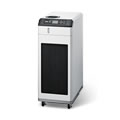
By entering the detailed information for the model selection,
the calculations will be carried out automatically to select a model that matches the site.
Those who are considering product introduction
![]()
Please feel free to contact us for inquiries such as on-site confirmation of product introduction, product details and prices.
Choosing a PCU Series model
Importance of the chiller selection
In order to operate the chiller stably, it is important to choose one that matches the operating conditions and circumstances of the equipment. It is also necessary to take note of the chiller installation location and the piping distance and shape, etc.
When selecting a chiller, it is important to match the operating conditions and circumstances with the functions, performance, and specifications of the chiller.
If this matching work is neglected, it is possible that after actually starting operation, the expected performance may not be demonstrated, or it may lead to problems occurring in the devices and chiller to be cooled themselves.
In addition to the set temperature of the workpiece (to be cooled) and the heat value problem, the selection of chiller models is not simple compared to the selection of other equipment, for example, the lifting height differs depending on the thickness, length, and shape of the piping connecting the workpiece and chiller.
Therefore, in this volume, we will introduce a selection method for choosing a chiller suitable for your facility in an easy-to-understand manner.
4 verification and determination processes for chiller selection
As mentioned above, it is important to select a chiller that is suitable for the equipment and work to be cooled. In order to select the most suitable chiller, there is a process of determination to be carried out while checking the operating conditions. Let’s select a chiller which is most suitable for the equipment by following 4 verification and determination processes introduced below.
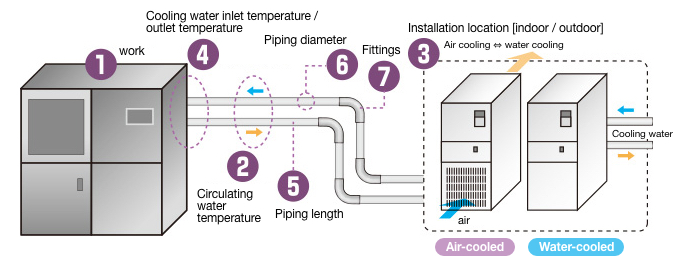
Structural diagram of chiller and workpiece (subject to cooling)
Chiller selection step 1: Specify circulated water temperature
The temperature of the circulating water is determined from the optimal temperature of the workpiece (device or process subject to cooling by the chiller).
(1) Determine the optimum temperature of the workpiece to cool.
(2) Determine the temperature of the circulating water.
Chiller selection step 2: Determine the installation location [outdoors ⇔ indoors] and cooling method [air cooling ⇔ water cooling]
(3) Decide whether to install the equipment outdoors or indoors, and whether the cooling method should be air-cooled or water-cooled.
○Outdoor installation (PCU-SL Series only)
- If you want to avoid the exhaust heat being discharged indoors (for air cooling)
- If you want to avoid air flowing indoors (for air cooling)
- If there is no space to install indoors
○Indoor installation
- If you want to run the chiller near the facility
- If you want to shorten the piping (reduce the pressure loss, reduce the piping cost)
- If you want to reduce the installation man-hours
●Water cooling [cooling the circulating water by heat exchange with the cooling water]
- When cooling water (tap water, well water, cooling tower, etc.) can be arranged
- When the exhaust and waste heat become a problem (when setting precise air conditioning, deterioration of the work environment, etc.)
●Water cooling [cooling the circulating water by heat exchange with the outside air]
- When cooling water (tap water, well water, cooling tower, etc.) cannot be arranged easily
- When the exhaust and waste heat due to air cooling are tolerable
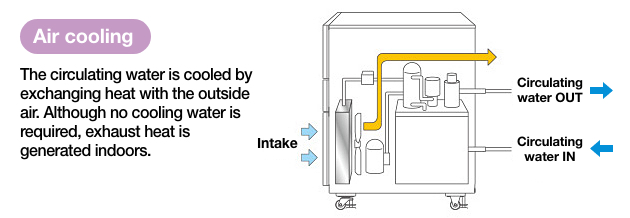
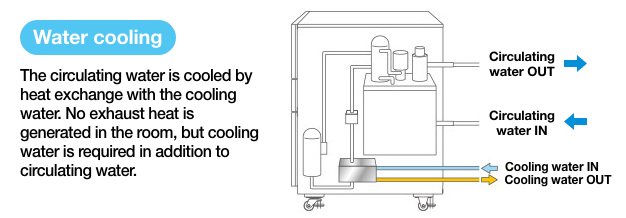
Features and internal structure diagrams of air-cooled chillers and water-cooled chillers
Chiller selection step 3: Specify cooling capacity
(4) Calculate the capacity required for cooling from the temperature changes in the workpiece, flow rate and temperature difference of the circulating water and so on.
For more information on how to determine the cooling capacity of chiller, refer to the calorific calculation method.
Chiller selection step 4: Check the required lifting height (pump capacity)
The required lifting height (capacity of the pump to deliver circulating water) varies depending on the piping conditions below.
Determine the required “lifting height” based on the piping length (5), pipe diameter (6), and the joints (7) (number of bends), and check whether the pump capacity of the selected chiller is sufficient.
For more information on how to calculate the required lifting height, refer to the lifting height calculation method.
Calorific calculation method
When choosing the capacity of the chiller,
(1) Calorific value of heat load < (2) Chiller cooling capacity
ensure that the condition above is satisfied. The calorific value of the heat load and the cooling capacity of the chiller are calculated by the following equation (calculation examples and reference materials are available).
(1) Calorific calculation method
PCU Series calorific calculation method
Calorific formula
Q[kW] =- Q: Load capacity [kW]
- (1) Vs: Volume of the object [m3]
- (2) Cs: Specific heat of the object [kJ/kg °C]
- (3) γs: Density of the object [kg/m³]
- (4) ΔT: Temperature difference of the object [°C]
- (5) t: Cooling time of the object [sec]
Calculation example (1)
When 800 L of hydraulic oil in the tank rises from 30 °C to 60 °C
Based on the physical properties table below, (2) 1.95, (3) 870, and (4) 60 - 30 = 30
perform unit conversion, (1) 800 L = 0.8 m3, (5) 1 h = 3600 sec
and substitute the values above into the formula to derive the value below
(0.8 × 1.95 × 870 × 30/3600) × 1.2 (safety factor) = 13.6 kW
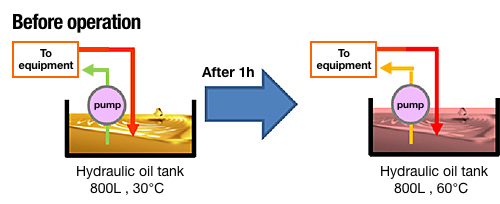
Calculation example (2)
When the cooling water flowing into the equipment is IN: 26 °C, OUT: 29 °C, and the flow rate is 45 L/min
Based on the physical properties table below, (2) 4.18, (3) 998, and (4) 29 - 26 = 3
decompose the flow rate into the denominator and numerator and convert the unit based on the following unit conversion table, 36 L/min = 36 L/min = 0.036 m3/60 sec. Therefore, (1) 0.036, (5) 60
and substitute the values above into the formula to derive the value below
(0.045 × 4.18 × 998 × 3/60) × 1.2 (safety factor) = 11.3kW
*When the circulating solution is water, assuming the physical properties etc. as coefficients, the value can also be determined by the equation below with just the temperature difference [ΔT] and the flow rate [A].
Q[kW] = 0.07 × A[L/min] × ΔT[℃]
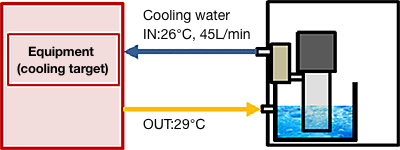
Calculation example (3)
After undergoing heat treatment, when you want to cool an iron workpiece with a mass of 3 kg from 250 to 40 °C in 3 minutes
Based on the physical properties table below, (2) 0.46, and (4) 250 - 40 = 210
perform unit conversion, (5) 3 min = 180 sec
convert the unit by multiplying the volume by the density i.e. volume [m3] × density [kg/m3] = mass [kg], so (1) × (3) = 3,
and substitute the values above into the formula to derive the value below
( 3 x 0.46 x 210 / 180) x 1.2 (Safety factor) = 1.93 kW
Unit conversion table
| (1) Volume Vs | 50 L | = 0.05 m3 |
|---|---|---|
| 100 L | = 0.1 m3 | |
| 1000 L | = 1 m3 | |
| (2) Specific heat Cs | 1 cal/g・℃ | = 4.18 kJ/kg・℃ |
| 1 kcal/kg・℃ | = 4.18 kJ/kg・℃ | |
| 1000 J/kg・℃ | = 1 kJ/kg・℃ | |
| (3) Densityγs | 1 g/cm3 | = 1000 kg/m3 |
| (5) Time t | 1 min | = 60 sec |
| 1 H | = 3600 sec |
Physical properties table
- When all the values are 20 °C.
- The values in the table are reference values. Apiste shall not be responsible for any calculation results obtained using this table.
| Name of substance | (2) Specific heat (kJ/kg・K) | Solar absorption rate | (3) Density (kg/m3) |
|---|---|---|---|
| Liquid | Water | 4.18 | 998 |
| Water-soluble cutting oil (water 90%) | 3.90~4.05 | 940~960 | |
| Lubricating oil | 1.80~1.95 | 850~870 | |
| Spindle oil | |||
| Hydraulic oil | |||
| Metal | Iron (steel) | 0.46 | 7870 |
| Aluminium | 0.91 | 2700 | |
| Copper | 0.39 | 8900 | |
| Brass | 0.38 | 8500 | |
| Zinc | 0.39 | 7150 | |
| Non-metal | Ceramic | 0.80 | 3600~3950 |
| Glass | 0.80~0.84 | 2600~2700 | |
| Bakelite | 1.59 | 1270 | |
| Resin | ABS (styrene, butadiene, etc.) | 1.35~1.65 | 1000~1150 |
| EP (epoxy resin) | 1.10 | 1850 | |
| PC (polycarbonate) | 1.25 | 1200 | |
| PE (polyethylene) | 2.30 | 910~960 | |
| PET | 1.25 | 1450~1670 | |
| PMMA (acrylic) | 1.48 | 1200 | |
| PP (polypropylene) | 1.95 | 900 | |
| PS (polystyrene) | 1.35 | 1030~1070 | |
| PVC (polyvinylchloride) | 0.85~2.1 | 1160~1450 |
(2) Chiller capacity verification method
The circulating water temperature (set temperature of the chiller), ambient temperature (for air cooling), and cooling water temperature (for water cooling) are verified and calculated from the characteristics graph of the target model.
Example) Determine the cooling capacity of the PCU-3300R when the circulating water temperature is 25 °C and the ambient temperature is 20 °C.
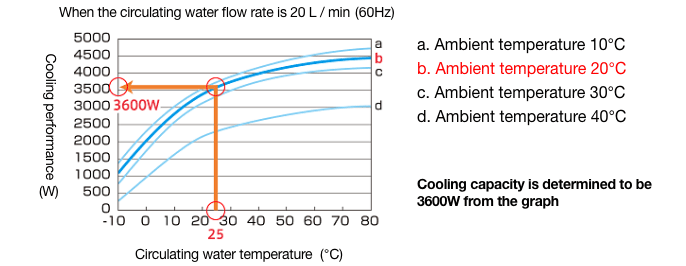
The cooling capacity determined from the graph above is 3600 W. (Selected at a frequency of 60 Hz)
How to calculate the lifting height
The power of the pump required to circulate the cooling water can be expressed by the “lifting height”.
The lifting height varies depending on the condition of the piping connecting the chiller to the load (equipment), but the calculated lifting height must ensure that the pump’s capacity is greater than the piping. A method of calculating the lifting height from the piping conditions, etc. is shown below.
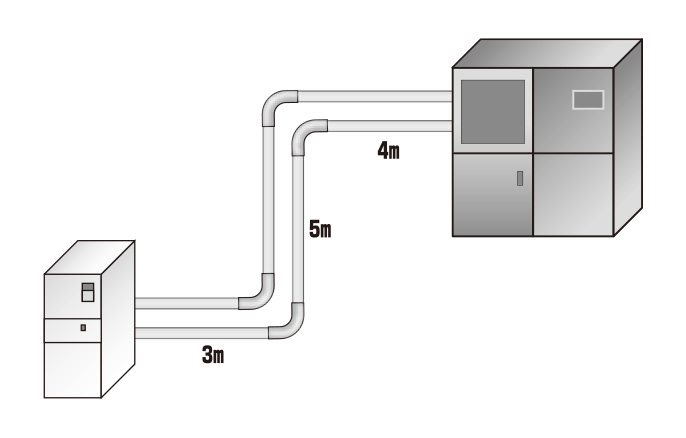
Step 1: Determine the piping length.
Length of piping from chiller to equipment:
3 + 5 + 4 = 12 m × 2 (to and fro) = 24 m…(1)
Step 2: Convert the resistance of the joint to a straight pipe length and add it to the piping length.
Determine the equivalent straight piping length of the joint from the table.
According to the table … Threaded type 90° short elbow 25 A → 1.6 m
1.6 x 4 (point) = 6.4m…(2)
(1)+(2)=24m+6.4m=30.4m…(3)
| Name | Joint shape | Pipe diameter (upper B) (lower mm) | ||||
|---|---|---|---|---|---|---|
| 1 | 1¼ | 1½ | 2 | 2½ | ||
| 25 | 32 | 40 | 50 | 65 | ||
| 90° Short elbow |
Screw | 1.6 | 2.0 | 2.3 | 2.6 | 2.9 |
| Flange | 0.5 | 0.6 | 0.7 | 0.9 | 1.1 | |
| 90° long elbow | Screw | 0.8 | 1.0 | 1.0 | 1.1 | 1.1 |
| Flange | 0.5 | 0.6 | 0.7 | 0.8 | 0.9 | |
As the resistance changes depending on the shape of the joint, check the value when converting to a straight piping length using the table above.
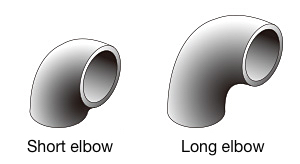
Step 3: Determine the “water head loss*Hf(m)” from the flow rate and piping diameter, and multiply it by the total piping length in “Step 2”.
If the flow rate is 30 L/min and the piping diameter is 25 A, based on the graph on the right, Hf = 0.04 Hf(m)…(4)
(3)×(4)=30.4×0.04=1.2(m)…(5)
*Water head loss: The pressure caused by friction in the pipe expressed by the piping diameter and the length of every meter of piping for each flow rate.
*Hazen–Williams formula
Hf=5.4775×10-3・C-1.85・D-4.87・Q1.85・L・α
(D: Inner diameter of piping, Q: flow rate, L: Piping length, α: Safety factor)
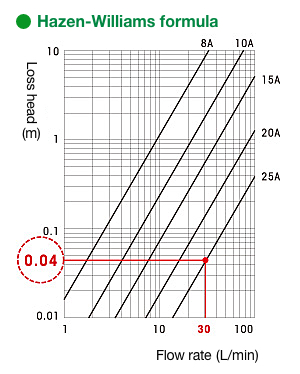
Step 4: Add the rising height from the chiller to the device to calculate the lifting height.
Height from chiller to device: If 5 m … (6) (5)+(6) = 1.2 (m) + 5 (m) = 6.2 (m)
Required lifting height is 6.2 m…(7)
Step 5: Select a pump that satisfies the lifting height calculated in Step 4.
At a flow rate of 30 L/min, the lifting capacity of the chiller shown in the graph has a lifting height of 35 m (for 60 Hz).
Therefore, the lifting capacity of this chiller satisfies the required lifting height (6.2 m).
35m > 6.2m
Example 1) Lifting height of PCU-3310R at a circulating water flow rate of 30 l/min (when required flow rate > rated flow rate)
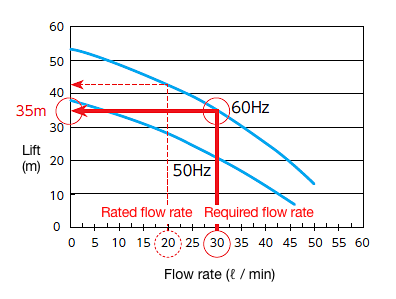
*The lifting height determined from the graph above is 35 m.
We're here to give you quick answers to your questions.
